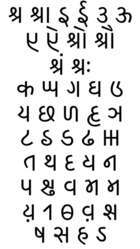| Kaithī Kayathi, Kayasthi, 𑂍𑂶𑂟𑂲 | |
|---|---|
 Kaithī script (vowels top three rows, consonants below) | |
| Script type | |
Time period | c. 16th–mid 20th century |
| Direction | Left-to-right |
| Languages | Awadhi, Bhojpuri, Hindustani, Magahi, Nagpuri, Maithili |
| Related scripts | |
Parent systems | |
Child systems | Sylheti Nagari |
Sister systems | |
| ISO 15924 | |
| ISO 15924 | Kthi (317), Kaithi |
| Unicode | |
Unicode alias | Kaithi |
| U+11080–U+110CF | |
| Brahmic scripts |
|---|
| The Brahmi script and its descendants |
Kaithi (𑂍𑂶𑂟𑂲), also called Kayathi (𑂍𑂨𑂟𑂲) or Kayasthi (𑂍𑂰𑂨𑂮𑂹𑂟𑂲), is a historical Brahmic script historically used across parts of Northern and Eastern India. It was prevalent in regions corresponding to modern-day Uttar Pradesh, Bihar, and Jharkhand. The script was primarily utilized for legal, administrative, and private records and was adapted for a variety of Indo-Aryan languages, including Angika, Awadhi, Bhojpuri, Hindustani, Maithili, Magahi, and Nagpuri.[1]



- ^ King, Christopher R. 1995. One Language, Two Scripts: The Hindi Movement in Nineteenth Century North India.New York: Oxford University Press.